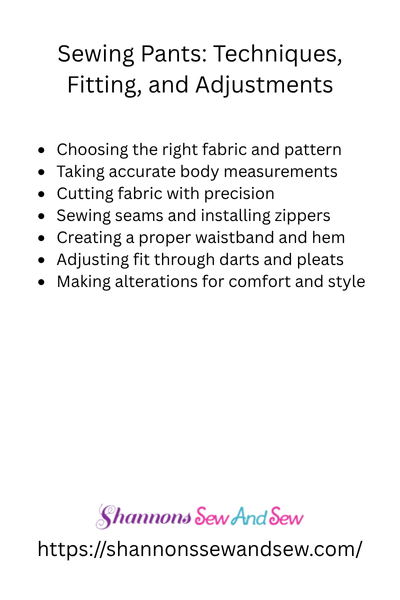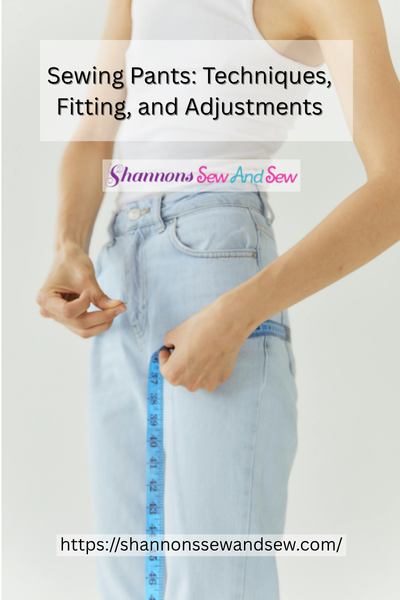Sewing Projects
Sewing Pants: Techniques, Fitting, and Adjustments
Sewing pants might sound like a big challenge, but with the right techniques and a little know-how, you can create a pair that fits like a glove. Whether you’re a seasoned pro or a complete newbie, mastering the art of pants fitting and adjustments will give you a wardrobe full of custom-made clothing that actually fits you just right. And let’s be real, nothing beats the satisfaction of sewing pants that fit you perfectly.
Read More About Sewing Pants: Techniques, Fitting, and Adjustments

The Importance of Proper Fitting
If you’ve ever tried on a pair of off-the-rack pants and thought, “What in the world is going on here?” you’re not alone. The fit of pants is so crucial to how they look and feel. Too tight? Uncomfortable. Too loose? You look like you’re swimming in fabric. The key to getting it just right is understanding the fit and making small adjustments where needed.
More Things to Know About Sewing Pants: Techniques, Fitting, and Adjustments

Start with the Right Pattern
Before you even think about cutting your fabric, choosing the right pattern is a must. When I first started sewing pants, I learned this the hard way. I picked a pattern that was “close enough” to what I wanted, but it turned out to be all wrong for my body. I ended up with a pair of pants that were too short in the crotch and too wide in the legs.
Here’s the trick: always double-check your measurements. Make sure you’re using a pattern designed for your body type. Patterns often come in different fit types—slim, regular, or relaxed. Take the time to choose one that matches your shape, so you’re not doing a ton of modifications later. Trust me, this will save you hours of frustration!
Understanding Pant Fitting
The fit of your pants depends on three main things: the waist, the hips, and the inseam. These are the areas that typically need the most attention when you’re adjusting a pattern or sewing pants from scratch.
- Waist: If you’ve got a smaller or larger waist than what’s standard for the pattern, you’ll need to make some adjustments. You can either add or subtract fabric from the side seams, or sometimes even the back seam if you’re dealing with a waistband that’s too tight or loose.
- Hips: The fit around the hips is just as important as the waist. You don’t want your pants to feel like they’re about to split when you bend over (I’ve been there), but you also don’t want excess fabric pooling around your thighs. If you’re working with a pattern that’s too tight, you can add a little extra width at the hip line.
- Inseam: Short or long, the inseam length can make or break the look of your pants. Always measure from the crotch to the hem to make sure they’re the right length for you. I always recommend trying on your pants at this stage and adjusting as needed before finishing the hem.
How to Adjust the Fit: A Step-by-Step Guide
Once you’ve got your pattern and fabric all set up, it’s time to get serious about making adjustments. Here are a few quick tips on how to get that perfect fit:
- Pinning and Basting: I can’t stress this enough—always baste your pants together before you start sewing for good. Pin the sides, inseam, and waistband, then try them on. This is your chance to make sure everything fits before committing to that final stitch. Don’t skip this step!
- Taking In the Waist or Hips: If the waist or hips are too large, you can make simple alterations by taking in the side seams. You’ll want to taper the seams gradually to avoid creating an awkward fit.
- Shortening or Lengthening: If your inseam is off, here’s a little secret I learned from experience: don’t just chop off fabric and hope for the best. If your pants are too long, make sure you measure from your ankle to where you want the hem to fall, and mark the fabric. Then, sew the hem accordingly. For shortening, you’ll need to adjust the pattern before cutting the fabric.
- Crotch Adjustments: Ah, the crotch. This is one of those areas that can make or break the entire pair of pants. If your pants feel tight in the crotch area or you find yourself pulling them up constantly, you might need to adjust the rise. Simply add or subtract fabric at the center front or back to create a better fit.
Little Tweaks Can Make a Big Difference
One thing I learned along the way is that small adjustments can totally transform the look of your pants. A little nip here, a tiny tuck there, and suddenly, you’ve got a pair of pants that fit like they were custom-made just for you.
For example, I once took a pair of pants that I thought would never fit properly and just tweaked the waistband a bit. I also shortened the inseam slightly, and guess what? They became my go-to pair of pants.
Sewing Pants Gets Better with Every Stitch
At the end of the day, sewing pants is all about patience, practice, and learning how to make the right adjustments. Whether you’re fitting pants for yourself or someone else, the techniques you learn will make all the difference in how your pants look and feel.
I hope my journey with sewing pants has inspired you to dive in, make those adjustments, and create a pair of pants that will soon become your new favorite. So go ahead—grab your fabric, pattern, and sewing machine, and start sewing pants that fit you perfectly. You’ve got this.




















